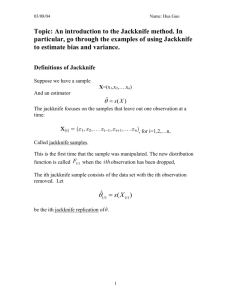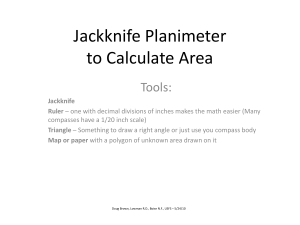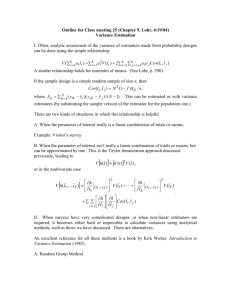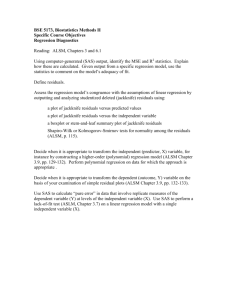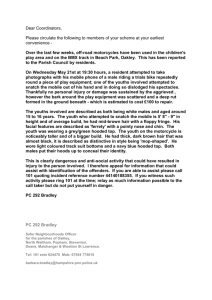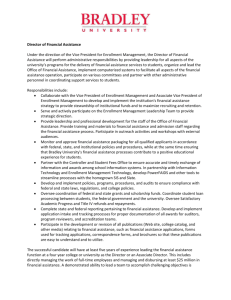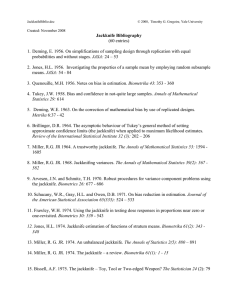estimates, tests, intervals Two locations: testing, estim
advertisement
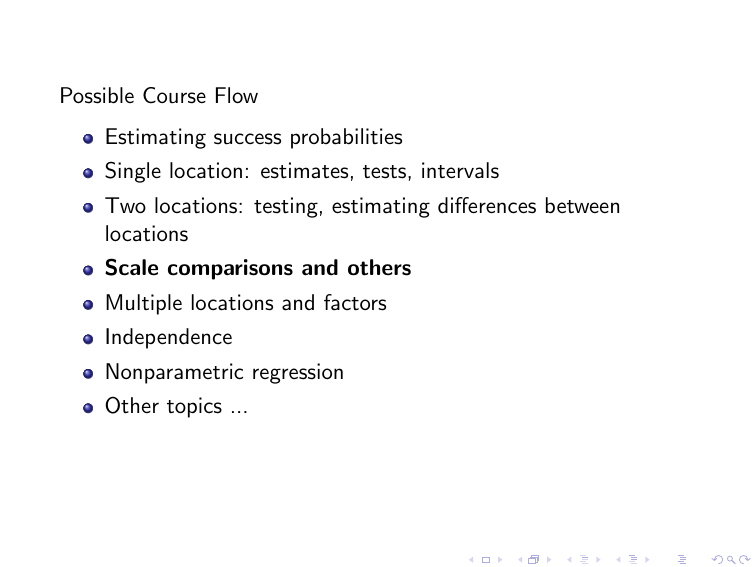
Possible Course Flow
Estimating success probabilities
Single location: estimates, tests, intervals
Two locations: testing, estimating differences between
locations
Scale comparisons and others
Multiple locations and factors
Independence
Nonparametric regression
Other topics ...
Two-Sample Problem
Compare two population centers via locations (medians)
Now, compare scale parameters
Perhaps same location, perhaps not
Even more generally, compare two distributions in all respects
Assumptions
Xi , i = 1, 2, . . . , m iid
Yi , i = 1, 2, . . . , n iid
N = m + n observations
Xi ’s and Yi ’s are independent
Continuous populations
F is distribution of X , population 1
G is distribution of Y , population 2
Ansari - Bradley Test
Distribution-free
Ranks again
Null:
H0 : F (t) = G (t) for all t
Same distribution (but no specified)
Assume same median θ1 = θ2
Ansari - Bradley Test
Interested in knowing if one distribution has different
variability than the other
Suppose
F (t) = H
t−θ1
η1
G (t) = H
t−θ2
η2
d
d
Equivalently: X = η1 Z + θ1 , Y = η2 Z + θ2 , with Z ∼ H
H is continuous with median 0 ⇒ F (θ1 ) = G (θ2 ) = 1/2
Further assumption: θ1 = θ2 (common median)
In summary,
X −θ d Y −θ
η1 = η2
If θ1 6= θ2 , but both are known, shift each sample:
Xi0 = Xi − θ1 , Yi0 = Yi − θ2 . Now have common median 0
Ansari - Bradley Test
Look at ratio of scales: γ = η1 /η2
If variances exist for X and Y , then
γ2 =
var(X )
var(Y )
Write null as
H0 : γ 2 = 1
Ansari - Bradley Test
Order the N combined sample values
Assign 1 to smallest and largest
Assign 2 to next smallest and next largest
Continue ...
Rj = score assigned to Yj
P
C = nj=1 Rj is the test statistic
Ansari - Bradley Test
One-tail alternative
H1 : γ 2 > 1
Reject H0 if C ≥ cα
Table A.8
Assumes Y is the smaller sample size (n ≤ m)
Ansari - Bradley Test
One-tail alternative
H1 : γ 2 < 1
Reject H0 if C ≤ c1−α − 1
Two-tail alternative
H1 : γ 2 6= 1
Reject H0 if C ≥ cα1 or C ≤ c1−α2 − 1
Typically set α1 = α2 = α/2 (valid for even N due to
symmetry)
Ansari - Bradley Test
Large sample approximation
When N even:
E (C ) = n(N+2)
4
var(C ) = mn(N+2)(N−2)
48(N−1)
Null distribution is symmetric ⇒ c1−α − 1 =
Otherwise:
n(N+1)2
4N
2
+3)
= mn(N+1)(N
48N 2
E (C ) =
var(C )
n(N+2)
2
− cα
Ansari - Bradley Test
CLT, standardize
C − E (C )
C∗ = p
∼ standard normal
var(C )
Need smaller of n and m large
Use zα , zα/2
Ansari - Bradley Test
Continuous ⇒ No ties, strictly increasing ranks
Ties will occur in practice
Give each group in tie the average of the scores
Approximately a level-α test
In large sample approximation, have different value for
variance
If N even,
var (C ) =
h P
i
mn 16 gj=1 tj rj2 − N(N + 2)2
16N(N − 1)
g is number of groups, tj is size of group, rj is average in
group
Assumptions
E (X ) E (Y ) may not exist
Only scale difference
Common median assumption is essential
Ansari - Bradley Test
Test H0 : γ 2 = γ0 with common median θ0 (known)
Use Xi0 = (Xi − θ0 )/γ0 and Yi0 = (Yi − θ0 )
Perform test with Yi0 and Xi0
Ansari - Bradley Test
R
ansari.test(x, y, exact, conf.int, conf.level)
Confidence interval (Bauer, Comment 12)
Estimates the ratio of the scales
R uses different method when ties cross the center point
Miller Jackknife Test
Medians not equal (or known)
Previous location-scale model assumption holds (Ansari Bradley)
Also assume: E (V 4 ) < ∞ where V ∼ H
This assumption implies that γ 2 is ratio of variances
Uses jackknife method
More applicable
Miller Jackknife Test
Jackknife is a resampling method
Sample the data repeatedly (without replacement), form
estimates for each sample
Combine these estimates; solutions are functions of the
estimates
In jackknife, each sample leaves out one particular piece of
data
If there are n pieces of data, then there are n jackknife samples
Sometimes referred to as “leave one out” method
General Jackknife Procedure
Let θ̂ be the estimate using all the data
For the i-th sample (without using piece i), calculate the
estimate θ̂(i) in the same way, i = 1, . . . , n
Form θ̃i = nθ̂ − (n − 1)θ̂(i) , i = 1, . . . , n
The jackknife estimate θ̂J is the mean of θ̃i , namely,
rP
The standard error of this estimate is given by
Why there’s an extra factor n?
P
θ̃i /n.
n
2
i=1 (θ̃i −θ̂J )
(n−1)n
Miller Jackknife Test
Get X i , Y j for each jackknife sample
X i is the sample mean without using data piece i
Also get sample variances for X and Y , leaving out one data
piece each time
The Miller test will also use full sample mean and sample
variance to construct test statistic
Miller Jackknife Test
m
Xi =
1 X
Xs
m−1
s6=i
m
Di2
1 X
=
(Xs − X i )2
m−2
s6=i
Get Y j and Ej2 for Y
Miller Jackknife Test
Set
Si = ln Di2 ,
i = 1, 2, . . . , m
Tj = ln Ej2 ,
j = 1, 2, . . . , n
Also get S0 and T0 using all data
ln: stable the variance, make the statistic more normal
Miller Jackknife Test
Set
V1 =
Ai = mS0 − (m − 1)Si ,
i = 1, 2, . . . , m
Bj = nT0 − (n − 1)Tj ,
j = 1, 2, . . . , n
m
X
(Ai − A)2
(estimate varĀ),
m(m − 1)
V2 =
i=1
A−B
Q=√
V1 + V2
m
X
(Bj − B)2
(estimate varB
n(n − 1)
i=1
Miller Jackknife Test
Write null as
H0 : γ 2 = 1
One-tail alternative
H1 : γ 2 > 1
Reject H0 if Q ≥ zα
Table A.1 or qnorm
Miller Jackknife Test
One-tail alternative
H1 : γ 2 < 1
Reject H0 if Q ≤ −zα
One-tail alternative
H1 : γ 2 6= 1
Reject H0 if Q ≤ −zα/2 or Q ≥ zα/2
Miller Jackknife Test
Asymptotically distribution free
F -test: extremely nonrobust
These are approximately α significance tests
Asymptotic tests - good as sample size → ∞
Not a rank test
No ties
Miller Jackknife Test
Estimate of ratio:
γ̃ 2 = e {A−B }
(1 − α) confidence intervals (approximately)
Two-sided
√
γU2 = e {A−B+zα/2 V1 +V2 }
√
γ 2 = e {A−B−zα/2 V1 +V2 }
L
One-sided (lower)
γL2 = e {A−B−zα
√
V1 +V2 }
One-sided (upper)
γU2 = e {A−B+zα
√
V1 +V2 }
Lepage Test
Test for either scale or location differences
Null:
H0 : F (t) = G (t) for all t
Alternative:
H1 : θ1 6= θ2 and/or η1 6= η2
Rank test
Large sample approximation
Section 5.3 (skip)
Kolmogorov - Smirnov Test
Test for differences in two populations
Not location, not scale specific
Assume X and Y independent (within and between samples)
H1 : any difference, F (t) 6= G (t) for at least one t
Commonly used test for Goodness of fit
Kolmogorov - Smirnov Test
Set
Fm (t) =
number of sample X ’s ≤ t
m
Gn (t) =
number of sample Y ’s ≤ t
n
Fm (t) and Gn (t) are empirical distribution functions which are
non-decreasing, step functions
0.0
0.2
0.4
Fn(x)
0.6
0.8
1.0
ecdf(x)
−1
0
1
2
x
3
4
Kolmogorov - Smirnov Test
J=
mn
max {|Fm (t) − Gn (t)|}
d −∞<t<∞
where d = greatest common divisor of n and m. Or
r
r
mn
mn
∗
Km,n (J ) =
Dm,n =
max |Fm (t) − Gn (t)|
m+n
m + n −∞<t<∞
Order the m + n values as Z(1) , Z(2) , . . . , Z(m+n)
Sufficient to consider these (finitely many) differences
Dm,n = max |Fm (Z(i) ) − Gn (Z(i) )|
i
Kolmogorov - Smirnov Test
Null:
H0 : F (t) = G (t) for all t
Alternative:
H1 : F (t) 6= G (t) for at least one t
Reject H0 if J ≥ jα
Table A.10 (X smaller)
Kolmogorov - Smirnov Test
Large sample approximation J ∗ =
r
Km,n =
√ Jd ,
mnN
or in fact
mn
Dm,n
m+n
Reject H0 if J ∗ ≥ qα∗
P(J ∗ ≥ qα∗ ) = α
Limiting distribution: Kolmogorov distribution (cf. (5.74)
P179)
Table A.11
Not normal
No ties
Kolmogorov - Smirnov Test
R
ks.test
Can test X and Y , or,
Test X against a particular distribution
pnorm(mean, sd), pexp(mean), etc.
(Skip 5.5)

